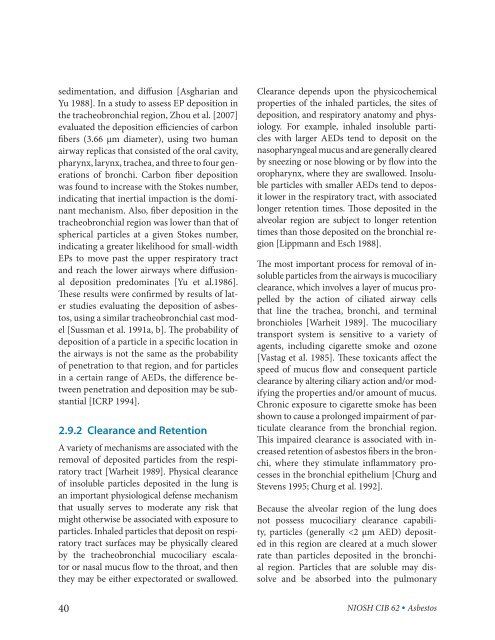Asbestos Fibers and Other Elongate Mineral Particles: State of the ...
Asbestos Fibers and Other Elongate Mineral Particles: State of the ...
Asbestos Fibers and Other Elongate Mineral Particles: State of the ...
- No tags were found...
You also want an ePaper? Increase the reach of your titles
YUMPU automatically turns print PDFs into web optimized ePapers that Google loves.
sedimentation, <strong>and</strong> diffusion [Asgharian <strong>and</strong><br />
Yu 1988]. In a study to assess EP deposition in<br />
<strong>the</strong> tracheobronchial region, Zhou et al. [2007]<br />
evaluated <strong>the</strong> deposition efficiencies <strong>of</strong> carbon<br />
fibers (3.66 µm diameter), using two human<br />
airway replicas that consisted <strong>of</strong> <strong>the</strong> oral cavity,<br />
pharynx, larynx, trachea, <strong>and</strong> three to four generations<br />
<strong>of</strong> bronchi. Carbon fiber deposition<br />
was found to increase with <strong>the</strong> Stokes number,<br />
indicating that inertial impaction is <strong>the</strong> dominant<br />
mechanism. Also, fiber deposition in <strong>the</strong><br />
tracheobronchial region was lower than that <strong>of</strong><br />
spherical particles at a given Stokes number,<br />
indicating a greater likelihood for small-width<br />
EPs to move past <strong>the</strong> upper respiratory tract<br />
<strong>and</strong> reach <strong>the</strong> lower airways where diffusional<br />
deposition predominates [Yu et al.1986].<br />
These results were confirmed by results <strong>of</strong> later<br />
studies evaluating <strong>the</strong> deposition <strong>of</strong> asbestos,<br />
using a similar tracheobronchial cast model<br />
[Sussman et al. 1991a, b]. The probability <strong>of</strong><br />
deposition <strong>of</strong> a particle in a specific location in<br />
<strong>the</strong> airways is not <strong>the</strong> same as <strong>the</strong> probability<br />
<strong>of</strong> penetration to that region, <strong>and</strong> for particles<br />
in a certain range <strong>of</strong> AEDs, <strong>the</strong> difference between<br />
penetration <strong>and</strong> deposition may be substantial<br />
[ICRP 1994].<br />
2.9.2 Clearance <strong>and</strong> Retention<br />
A variety <strong>of</strong> mechanisms are associated with <strong>the</strong><br />
removal <strong>of</strong> deposited particles from <strong>the</strong> respiratory<br />
tract [Warheit 1989]. Physical clearance<br />
<strong>of</strong> insoluble particles deposited in <strong>the</strong> lung is<br />
an important physiological defense mechanism<br />
that usually serves to moderate any risk that<br />
might o<strong>the</strong>rwise be associated with exposure to<br />
particles. Inhaled particles that deposit on respiratory<br />
tract surfaces may be physically cleared<br />
by <strong>the</strong> tracheobronchial mucociliary escalator<br />
or nasal mucus flow to <strong>the</strong> throat, <strong>and</strong> <strong>the</strong>n<br />
<strong>the</strong>y may be ei<strong>the</strong>r expectorated or swallowed.<br />
40<br />
Clearance depends upon <strong>the</strong> physicochemical<br />
properties <strong>of</strong> <strong>the</strong> inhaled particles, <strong>the</strong> sites <strong>of</strong><br />
deposition, <strong>and</strong> respiratory anatomy <strong>and</strong> physiology.<br />
For example, inhaled insoluble particles<br />
with larger AEDs tend to deposit on <strong>the</strong><br />
nasopharyngeal mucus <strong>and</strong> are generally cleared<br />
by sneezing or nose blowing or by flow into <strong>the</strong><br />
oropharynx, where <strong>the</strong>y are swallowed. Insoluble<br />
particles with smaller AEDs tend to deposit<br />
lower in <strong>the</strong> respiratory tract, with associated<br />
longer retention times. Those deposited in <strong>the</strong><br />
alveolar region are subject to longer retention<br />
times than those deposited on <strong>the</strong> bronchial region<br />
[Lippmann <strong>and</strong> Esch 1988].<br />
The most important process for removal <strong>of</strong> insoluble<br />
particles from <strong>the</strong> airways is mucociliary<br />
clearance, which involves a layer <strong>of</strong> mucus propelled<br />
by <strong>the</strong> action <strong>of</strong> ciliated airway cells<br />
that line <strong>the</strong> trachea, bronchi, <strong>and</strong> terminal<br />
bronchioles [Warheit 1989]. The mucociliary<br />
transport system is sensitive to a variety <strong>of</strong><br />
agents, including cigarette smoke <strong>and</strong> ozone<br />
[Vastag et al. 1985]. These toxicants affect <strong>the</strong><br />
speed <strong>of</strong> mucus flow <strong>and</strong> consequent particle<br />
clearance by altering ciliary action <strong>and</strong>/or modifying<br />
<strong>the</strong> properties <strong>and</strong>/or amount <strong>of</strong> mucus.<br />
Chronic exposure to cigarette smoke has been<br />
shown to cause a prolonged impairment <strong>of</strong> particulate<br />
clearance from <strong>the</strong> bronchial region.<br />
This impaired clearance is associated with increased<br />
retention <strong>of</strong> asbestos fibers in <strong>the</strong> bronchi,<br />
where <strong>the</strong>y stimulate inflammatory processes<br />
in <strong>the</strong> bronchial epi<strong>the</strong>lium [Churg <strong>and</strong><br />
Stevens 1995; Churg et al. 1992].<br />
Because <strong>the</strong> alveolar region <strong>of</strong> <strong>the</strong> lung does<br />
not possess mucociliary clearance capability,<br />
particles (generally

















